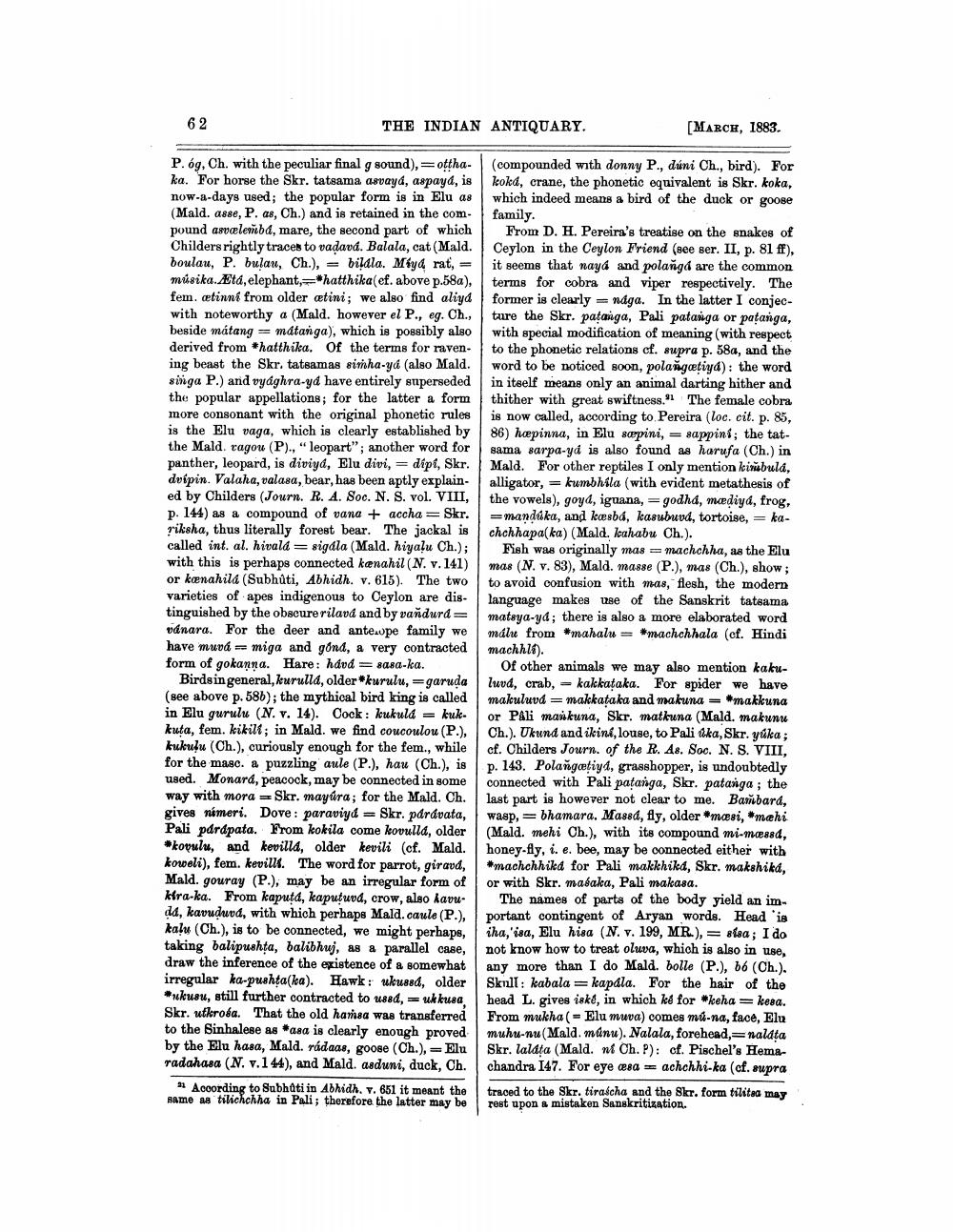________________
62
THE INDIAN ANTIQUARY.
[MARCH, 1883.
P. óg, Ch. with the peculiar final g sound), ottha. (compounded with donny P., dúni Ch., bird). For ka. For horse the Skr. tatsama asvayd, aspayd, is kokd, crane, the phonetic equivalent is Skr. koka, now-a-days used; the popular form is in Elu as which indeed means a bird of the duck or goose (Mald. asse, P. as, Ch.) and is retained in the com- family. pound asvælemba, mare, the second part of which From D. H. Pereira's treatise on the snakes of Childers rightly traces to vadavá. Balala, cat (Mald. Ceylon in the Ceylon Friend (see ser. II, p. 81 ff), boulau, P. bulau, Ch.), = bilala. Miyd rat, = it seems that nayd and polañgd are the common musika. Æta, elephant,="hatthika(ef. above p.58a), terms for cobra and viper respectively. The fem. tinni from older ætini; we also find aliyd former is clearly = naga. In the latter I conjecwith noteworthy a (Mald. however el P., eg. Ch., ture the Skr. patanga, Pali patanga or patanga, beside mátang = matanga), which is possibly also with special modification of meaning (with respect derived from *hatthika. Of the terms for raven to the phonetic relations cf. supra p. 58a, and the ing beast the Skr. tatsamas simha-yd (also Mald word to be noticed soon, polañgætiyd): the word singa P.) and vyághra-ya have entirely superseded in itself means only an animal darting hither and the popular appellations; for the latter a form thither with great swiftness. The female cobra more consonant with the original phonetic rules is now called, according to Pereira (loc. cit. p. 85. is the Elu vaga, which is clearly established by 86) hæpinna, in Elu sæpini, = sappins; the tatthe Mald, ragou (P).." leopart"; another word for sama sarpa-yd is also found a harufa (Ch.) in panther, leopard, is diviyd, Elu divi, = dipt, Skr. Mald. For other reptiles I only mention kiribula, dvipin. Valaha, valasa, bear, has been aptly explain- alligator, = kumbhila (with evident metathesis of ed by Childers (Journ. R. A. Soc. N. S. vol. VIII, the vowels), goyd, iguana, = godha, mcediyd, frog, p. 144) as a compound of vana + accha=Skr. = mandáka, and kæsbá, kasubuvd, tortoise, = kariksha, thus literally forest bear. The jackal is chchhapa(ka) (Mald, kahabu Ch.). called int. al. hivalá = sigala (Mald. hiyalu Ch.); Fish was originally mas = machchha, as the Elu with this is perhaps connected kenahil (N. v. 141) mas (N. v. 83), Mald. masse (P.), mas (Ch.), show; or kænahild (Subhùti, Abhidh. v. 615). The two to avoid confusion with mas, flesh, the modern varieties of apes indigenous to Ceylon are dis- language makes me of the Sanskrit tateama tinguished by the obscure rilavd and by vandurd = matsya-yd; there is also a more elaborated word vánara. For the deer and ante pe family we málue from #mahalu #machchhala (cf. Hindi have muvá miga and gond, a very contracted machhlt). form of gokanna. Hare: hävd = sasa-ka.
Of other animals we may also mention kakuBirdsin general,kurulla, older kurulu, garuda luvd, crab, -kakkataka. For spider we have (see above p. 586); the mythical bird king is called makuluvd = makkataka and makuna -*makkuna in Elu gurulu (N. v. 14). Cock: kukuld = kukor PAli mankuna, Skr. mattuna (Mald. makunu kuta, fem. kikilt; in Mald. we find coucoulou (P.), Ch.). Ukund and ikink, louse, to Pali aka, Skr.yúka; kukufu (Ch.), curiously enough for the fem., while cf. Childers Journ. of the R. 48. Soc. N. S. VIII, for the masc. a puzzling aule (P.), hau (Ch.), is p. 143. Polangetiyd, grasshopper, is undoubtedly used. Monard, peacock, may be connected in some connected with Pali patanga, Skr. patanga ; the way with mora = Skr. mayúra; for the Mald. Ch. last part is however not clear to me. Barbard, gives nimeri. Dove: paraviyd = Skr. pardvata, wasp,=bhamara. Massd, fly, older *mosi, *mehi Pali pdrapata. From kokila come kovulla, older (Mald. mehi Ch.), with its compound mi-mæssd, *kovulu, and kevilla, older kevili (cf. Mald. honey-fly, i.e. bee, may be connected either with kowoli), fem, kevill. The word for parrot, girand, #machchhikd for Pali makkhika, Skr. makshika, Mald. gouray (P.), may be an irregular form of or with Skr. masaka, Pali makasa. kira-ka. From kaputá, kaputuvd, crow, also kavu. The names of parts of the body yield an imda, kavudund, with which perhaps Mald. caule (P.), portant contingent of Aryan words. Head 'is kalu (Ch.), is to be connected, we might perhaps, iha, isa, Elu hisa (N. v. 199, MR.), = sisa; I do taking balipushta, balibhuj, as a parallel case, not know how to treat oluva, which is also in use, draw the inference of the existence of a somewhat any more than I do Mald. bolle (P.), bó (Ch.). irregular ka-pushta(ka). Hawk: uused, older Skull: kabala = kapala. For the hair of the * ukusu, still further contracted to usad, ukusa. head L. gives iská, in which kd for "keha = kesa. Skr. utkroba. That the old hansa was transferred From mukha(- Elu muva) comes mú-na, face, Elu to the Sinhalese as *asa is clearly enough proved muhu-nu (Mald. manu). Nalala, forehead,=nalata by the Elu hasa, Mald. rádaas, goose (Ch.), Elu Skr. laldta (Mald. ni Ch.P): cf. Pischel's Hemaradahasa (N. v.1 44), and Mald, asduni, duck, Ch. chandra 147. For eye esa = achchhi-ka (cf. supra
1 According to Subhati in Abhidh. v. 651 it meant the traced to the Skr. tira cha and the Skr. form tilitoa may same as tilichchha in Pali; therefore the latter may be rest upon a mistaken Sanskritization.




